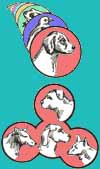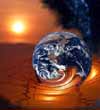 | 

The Definition of Science and Its Relationship to the Study of Origins. (Sidebar 1)
Defining Science
 |
The textbook definition of science is "knowledge that is obtained by the scientific method (i.e observation, experimentation, and measurement)."

The nature of science is that it is observable, testable, reproducible, and potentially falsifiable.

Science is limited in two aspects: it cannot test things that happened in the past, and it cannot test non-physical entities. Are theories of origins "scientific"? | 
| 
Two Views on the Origin of the Universe
| Defining Creation

 |
Creationism has been defined in two ways, and while the two definitions are complementary, they each can be discussed independently.

"Biblical Creationism" refers to the supernatural creation of all things in six literal days by the God of the Bible.

"Scientific Creationism" refers to the appearance of each basic category of life abruptly without descent from a common ancestor of a different sort. Much variation within a category is expected, but each category possesses genetic limits to its variability and thus exhibits stasis (Morris, 1994). | Defining Evolution

 |
Evolution has a variety of definitions. It can simply refer to "change". Typically, however, it refers to Darwinian biological evolution—that "all life has come from a common ancestor through a process of modification over time. The man and the apes are thought to have descended from an ape-like common ancestor. All vertebrates came from fish, which in turn came from an invertebrate. All life descended from a single-celled organism which arose spontaneously from non-living chemicals. Changes occurred through natural processes, including mutation, natural selection, and genetic recombination" (Morris, 1994).

A distinction should be made between microevolution and macroevolution.

Microevolution refers to small adaptations within a population of organisms which allow a certain trait to be expressed to a greater or lesser degree than before; in essence—variation within a category. These are regularly observed to occur within living populations.

Macroevolution refers to large hypothetical changes which occur in an individual or in a population of organisms which produce an entirely new category or novel trait. These changes have never been observed to occur within living populations, but have been extrapolated from observed microevolution (or variation). | 
| 
Science and Origins
| Defining Origins

 |
Because the origin of life and of the universe cannot be observed, reproduced, or tested, origins are outside the limits of empirical science. Creation is a completed act and is not taking place now. Evolution "occurs too slowly to be measured", and so neither can be observed. We cannot repeat history, so the first act of origins cannot be repeated. Also, we cannot test a theory of origins. Even if we were to prove that evolution or creation could happen, that does not prove that it did happen. Creation and evolution properly fall into the category of "models." A model is "a conceptual framework, an orderly system of thought, within which one tries to correlate observable data and even to predict data" (Morris, 1974). Using a model, one can make predictions about what kinds of evidence would be expected. Two alternative models can be compared and then it can be seen which model fits the facts and predictions with the smallest number of secondary assumptions. "The model that enables us to do the best job of predicting things which we then find to be true on observation is the model most likely to be true, even though we cannot prove it to be true by actual scientific repetition" (Morris and Parker 1982). | 
| 
Introduction to the Creation and Evolution Models
| Creation
Model of
Origins
|
The creation model of origins predicts first, that since God created all things perfect and fully-functioning, there will be a net basic decrease in information and complexity over time due to the deleterious effects of the Fall. Second, biology is limited to "horizontal" changes, or variations within a "created kind" and this should also be seen in the fossil record. Third, in geology, Earth history is dominated by catastrophic events as a result of the Flood of Noah's time. Fourth, at least some things must be attributed to completed, supernatural processes in an open universe.
 | Evolutionary
Model of
Origins
|
The evolutionary model of origins predicts first, that there is a net basic increase in complexity over time. Second, biology is characterized by unlimited "vertical" changes, or progression from simple life forms to more complex ones. Third, in geology, Earth history is dominated by uniform events, with few significant catastrophes. Fourth, all things in the world and universe can be explained with naturalistic mechanisms by chance, random mutations, and natural selection.
 |
 Is There Evidence Against Evolution? Is There Evidence Against Evolution?
 Supplemental Reading Supplemental Reading
 What is the Difference Between Macroevolution and Microevolution? What is the Difference Between Macroevolution and Microevolution?
 Supplemental Reading Supplemental Reading

References
Morris, John D. 1994. The Young Earth. Master Books. Green Forest, AR. p.10Morris, H. 1974. Scientific Creationism Master Books. Green Forest, AR. p.9. Morris, H. and Parker, G. 1982. What is Creation Science? Master Books. Green Forest, AR. p.9.

 |

